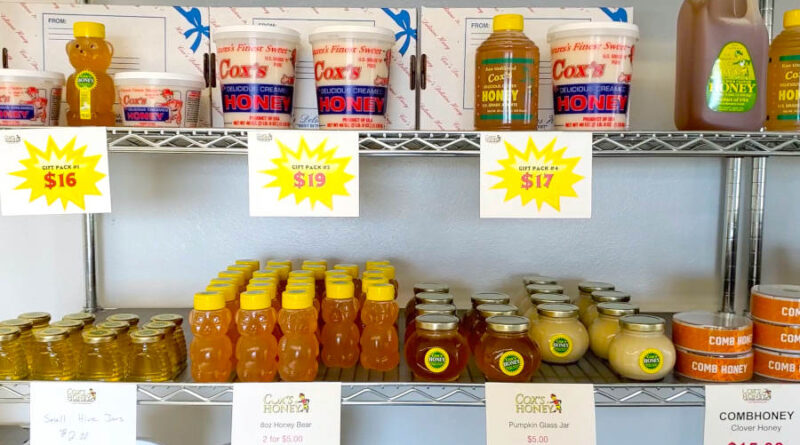What makes Cox’s Honey so sweet
SHELLEY — In 1927, a young man took over his father’s bee colonies and started his own business; nearly one hundred years later, what that business blossomed into is pretty sweet.
Orville Cox, born into a polygamist family, was the youngest of 22 children. At their home in Orderville, Utah, in the 1880s, Orville’s family raised sheep, cattle and kept a few colonies of bees. Eventually, Orville’s father and the rest of the Cox family packed up and moved to Shelley. They brought their bees with them.
“(Orville) served a mission in Africa. By the time he got back, all the other children had found their vocations and everything,†Roy Cox, one of Orville’s sons, told Community Pioneer. “My father found the only thing he had leftover were the bees.”
Cox’s Honey CFO Adam French said Orville went to local farmers, many of whom kept bees of their own, and offered his skills as an experienced beekeeper. In return, he asked if he could keep the honey their bees produced.
“The farmers were like ‘you can keep the bees as long as you just bring them back during the season so they can pollinate our crops,'” French explained.
That’s just what Orville did. Between shifts working at Shelley’s sugar beet factory, he took care of the bees, rotating them through farmer’s fields pollinating their crops. He’d then harvest and sell the honey.
“Pretty soon, he was making more money doing that than what he was working at the sugar factory,” Roy said.
Roy explained his father was a natural salesman. Orville peddled his honey door to door; and with every sale, his reputation grew. Eventually, everyone around knew the best honey came from Orville Cox. Cox’s Honey was born.
The family business
“I was born in 1943,” Roy Cox said. “By the time I was about six years old, I was out in the backyard–we had a few bees in the backyard–helping him. I was doing the smoking, making sure that the bees would keep calm.”
Roy and his brother Merrill helped their dad with every aspect of the family business. But as Roy grew older, he began wondering if he wanted to spend his life keeping bees.
“I got thinking about this, ‘man, I wouldn’t do this for anything,'” Roy said.
In high school and through college, Roy’s thinking shifted. He decided he might want to stay in the honey business. After all, it was better than being stuck in an office doing the same thing day in and day out for the rest of his life.
“Getting out with the bees, that was by far the best,” Roy said about his favorite part of the honey trade. “You’d be out in the good weather, watching them hum, watching them bring in the honey, learning their behaviors. I learned quite a bit about them.”
In 1970, Roy and Merrill took over their father’s business.
“It wasn’t so much about making the big dollars as enjoying what you’re doing,” Roy said.
Under Merrill and Roy’s leadership, Cox’s Honey kept on growing as more people tasted its sweet products. Eventually, the brothers passed the business on to Brent Cox, Brian Cox and Kendell Brunson, all members of the Cox family. In 2006, Adam French joined the company.
Cox’s Honey now ships all over the country, and the world. The list of retail stores selling Cox’s Honey is expanding and people anywhere can purchase its products through Amazon.
What sets Cox’s Honey apart from all the other honey producers? What brings people back?
The secret is in the flowers (and a little ingenuity)
“There’s not much you can do about the flavor of honey; you’re going to get whatever those bees are gathering,” Roy Cox said. “If you’re going to extract dandelion, then it’s going to taste like dandelion. If you’re going to extract sage honey, it’s going to taste like sage. In this area, it’s mostly clover.”
High mountain clover, to be exact.
“High mountain clover has a more mild taste (and) it has a supreme flavor,” Adam French explained.
While their raw clover honey is certainly exceptional, they aren’t the only ones producing it. However, they do have one unique product no one else has seemingly been able to get right: Cox’s Creamed Honey.
“There’s a lot of people who have whipped honey, they try to do the creamed honey. But nobody does it quite like Cox’s Honey,” French said.
Honey crystallizes over time. Crystallized honey isn’t ruined — pure honey doesn’t spoil — it can be melted. But melting it is time-consuming. Worse, after melting crystallized honey, it will quickly harden again.
Honey producers during Orville’s day were no strangers to this problem. Some tried to capitalize on crystallized honey by whipping it. But the whipped honey was still gritty.
Orville had a different idea.
“He came up with an idea of running it through a mill. And that mill, what that does is it breaks down all the crystals, breaks down the granules so that it’s smooth,” French said. “It gave it a creamy texture where it’s really smooth and it turns bright white.”
Roy said once Orville perfected his creamed honey, he took it back east to a honey convention.
“His honey took the prize for being the best creamed honey that was there,” Roy said. “Once he came back with that little bit of publicity behind it, more people wanted to try it. And once they tried it, they just about couldn’t turn it down from then on. They just went for it.”
Even as Cox’s Honey has grown and become ever-more popular, the original Cox homestead still stands on State Street in Shelley. Patrons can still visit and purchase a variety of honey products: Beeswax candles, honeycomb, raw clover honey and, of course, Cox’s Creamed Honey.





